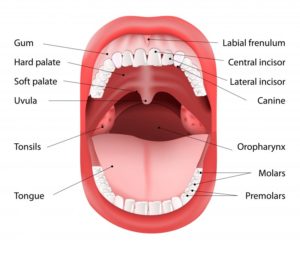Why Understanding Your Mouth’s Anatomy Promotes Oral Care
November 4, 2021

The human body is similar to the car you drive each day – the better you understand how each one works, the more effectively you can take care of it. Narrowing the focus, the more familiar you are with the parts of the mouth, the better you can practice good oral care.
Some parts of the mouth affect your teeth and gums more than others and are crucial to preventing tooth decay and gum disease. Other components display symptoms of diseases such as oral cancer, providing important diagnostic clues for your dentist in Chaska. Keep reading to learn about what your oral health involves.
Your Salivary Glands, Gums, and Alveolar Bone Help Your Teeth
You have six salivary glands that produce the clear liquid known as saliva, which is made up predominantly of water and contains substances that break down food to begin the digestive process. Saliva also moistens your mouth to help with speaking, chewing, and swallowing.
Plus, it washes bacteria from your teeth and gums. The proteins and minerals in saliva play a vital role in protecting the enamel, as well.
Your mouth’s gum tissue holds your teeth in place and protects the roots from decay. You may be familiar with gum disease, and the main symptoms include swelling and chronic bleeding. These warning signs are important because unchecked gum disease can lead to tooth and bone loss.
On the other hand, the alveolar bone is not a well-known portion of the mouth. The roots of your teeth anchor them in your jawbone. The alveolar bone surrounds the roots to stabilize the teeth.
How Do My Tongue, Lips, and Cheeks Benefit My Teeth?
The tongue is a powerful muscle that facilitates chewing, swallowing, speaking, and tasting food. Taste buds, sensory receptors on your tongue, enable you to enjoy the food you eat. In fact, the human tongue can have up to 10,000 taste buds, which help you detect sweet, salty, bitter, and savory flavors.
The pressure the tongue applies within the mouth helps the oral cavity maintain its shape and keeps the teeth properly positioned.
Your lips and cheeks contribute to everything from forming your facial expressions to breathing and speaking. They also keep food and saliva in your mouth while you chew. These strong muscles brace your teeth to keep them in the proper position.
What Is the Purpose of Temporomandibular Joints?
This part of the mouth is rarely discussed. Your two temporomandibular joints facilitate your ability to chew, speak, and swallow. They also enable your mouth to open and close, as well as allow you to move your lower jaw forward and side to side.
These joints are located on both sides of your head near your ears and work together with your jawbone, facial muscles, and ligaments. Any disruption to the synchronization of this pair, which can happen if you grind your teeth at night, can result in facial pain, difficulty in chewing, and jaw stiffness.
It’s great that you are taking care of your teeth but be sure not to neglect the other parts of your mouth. Rinse with an antimicrobial mouthwash, brush your tongue and your gums, and visit your dentist twice each year so they can check your entire mouth for signs of disease in addition to providing the thorough cleaning that will keep your oral health in good standing.
About the Author
Dr. Mark Stapleton earned his Doctor of Dental Surgery from the University of Minnesota. He has achieved Fellowship status in the Academy of General Dentistry, which demonstrates a top-tier level of commitment to clinical excellence and lifelong education. He actively attends courses at Spear Education and the Dawson Academy and stays active in a local Spear Study Club alongside other dentists and specialists. If this blog post sparked a question for you about oral anatomy, be sure to ask Dr. Stapleton about it during your dental cleaning and exam. To make an appointment, you can visit his website or call (952) 448-2868.
No Comments
No comments yet.
RSS feed for comments on this post.
Sorry, the comment form is closed at this time.
